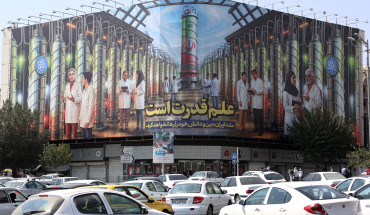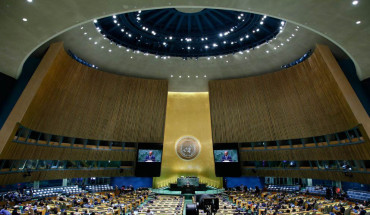This Commentary first appeared as an op-ed on ForeignPolicy.com’s Middle East Channel, April 30, 2010.
Iran's Green Movement has been laying low for the past few months after massive coercive measures carried out by government-sponsored forces, but many believe that the embers of the movement continue to burn. The "people are just waiting for a spark," Mehdi Karoubi, a presidential contender and opposition leader recently told Der Spiegel. Former reformist president Mohammad Khatami has warned that the new Persian Year, which started on March 20, will be the "year of social crises" if the Ahmadinejad administration's "mismanagement" and "strategy of lies" continue. But many analysts wonder whether the Green Movement has a strategy to capitalize on such opportunities, or even to survive in the face of government repression.
While it may be an exaggeration to say that the decentralized Green Movement has a single "strategy," the approach of its top leaders suggests that their hopes lie in exploiting the "Grey Zones" in Iranian society through a strategy of patience and endurance. The Green Movement already enjoys the support of millions of restless young and female Iranians, many of whom hope for radical change. But Mir Hossein Mousavi and other top leaders are fixated on what they calls the "grey area" made up of religious associations and traditional factions that do not quite support the Green Movement, but are also quietly unhappy with the rise of Mahmoud Ahmadinejad. By pledging unconditional loyalty to the foundations of the Islamic Republic, the leaders of the Green Movement opt to attract or at least neutralize these "moderate conservatives" and many influential figures in various religious and political circles.
This strategy rests on the ability of the Green Movement to broaden its appeal into those conservative "Grey Zones." It has already created an unprecedented gap within the conservative establishment. Capitalizing on their impeccable revolutionary resumes that date back to the consolidating years of the Islamic Republic, the leaders of the Green Movement have striven to push the fault-line as deep as possible into the conservative camp so that when the next crisis hits, they can draw deeper into society for support.
If it was an election that brought millions of people to the streets last year, the next round of protests could be triggered by social and economic problems and the skyrocketing inflation rate that is predicted to occur if President Ahmadinejad succeeds in removing subsidies on basic commodities. The failure of Ahmadinejad's social and economic policies may create dissatisfaction among the lower social strata that are reportedly his main constituency. Khatami has argued that only the "return to the law" and a more inclusive political process in which all factions are "hand in hand" could weather this looming storm.
Many reformists believe that the record-high oil cash flush of the past few years, Iran's perceived foreign policy successes in Iraq, Afghanistan, Lebanon, and Gaza, and the continued expansion of Iran's nuclear program have made Iran's leaders over-confident. If things go worse for them, would the establishment be willing to compromise with an opposition that does not miss an opportunity to emphasize its loyalty to the constitution of the Islamic Republic? So far there is no sign to suggest that the conservatives are eager to negotiate with the internal opposition. But, they wonder, perhaps a sharper crisis would compel Ayatollah Khamenei to shift his support from ultra-conservative elements to more centrist factions.
Iran's political evolution offers some support for this hope. In the 1980s, Ayatollah Khomeini, the founding father of the Islamic Republic, consistently ensured a balance between two political factions: the Right (conservatives) and the Left (radicals). After his death, the former managed to remove the latter from the political scene. But this did not last long, as the Left reinvented itself and came back as reformists in a landslide election in 1997. It took Ayatollah Khamenei eight years to remove the Left/reformists from the political arena once more and replace them, not just with the conservatives, but this time with an ultra conservative faction consisting of a younger generation of revolutionary figures such as the current president. If Ayatollah Khomeini expunged the liberals, Marxists, and other political groups after the revolution and then struck a balance between the two wings of his Islamist faction, his successor, Ayatollah Khamenei, has removed the reformists, the "new liberals," in order to strike a balance within his own faction between the "traditional right" and the "new right."
A brief look at Iranian newspapers from the 1980s can give us a sense of how lonely the Supreme Leader may be these days. These papers were often covered with pictures and statements of the then top five leaders of the country: 1) the late Ayatollah Khomeini, whose family is now supportive of the opposition; 2) Ayatollah Montazeri, an architect of the Islamic Republic and later long time dissident cleric whose death back in December on the holy day of Ashura gave a major boost to the Green Movement; 3) Ali Akbar Hashemi Rafsanjani, the powerful head of the Majles and de facto number two politician in the 1980s, now the head of two important bodies: the Expediency Council and the Assembly of Experts. Rafsanjani facilitated Ayatollah Khamenei's ascendance to leadership in 1989, however he now backs Mousavi; 4) then Prime Minister Mousavi, who enjoyed the unequivocal approval of Ayatollah Khomeini for eight years even in the face of numerous unsuccessful attempts to be removed by then President Khamenei; and 5) Ayatollah Khamenei, who in the 1980s was only a ceremonial president with limited authority but is now by far the most powerful man in the country.
Today there is no question that Ayatollah Khamenei is in full control of Iran and its much-dreaded military and security forces that can make life difficult for the U.S. and its regional allies. But it is no secret that his domestic challengers are the last children of the revolution who cannot be devoured so easily. Currently, President Ahmadinejad and his far right allies control Iran's executive branch, while the Larijani brothers, who are seen as more "moderate" elements closer to the traditional right, dominate the judiciary and legislative branches. The ever-existing tension between these two sub-factions primarily evident in fiery debates in the Majles (parliament), proving that there is little mutual respect between the two camps. Nevertheless, this new balance between the "new right" and the "traditional right" cannot easily replace the old political equilibrium. The permanent removal of the Left/reformists is seen as simply too big for Ayatollah Khamenei to swallow.
Equally afraid of massive bloodshed or a sudden collapse of the entire system, the opposition leaders are today pushing for a shift to "moderation," where the old balance is re-established. But this time, based on more "rational" social, economic and foreign policies. Many supporters of the Green Movement may wish for more radical change to bring about a secular political system. But for now they seem to continue to back the current opposition leaders and hope that guaranteeing the implementation of the current constitution, despite its shortcomings, could pave the way for other, more fundamental, changes. And it is precisely the fear of a slippery slope that has prevented Ayatollah Khamenei from making any shift to the center. But the opposition believes time is on its side and that its "gray" strategy of patience combined with the vital role of the new media in spreading its message will eventually force Ayatollah Khamenei to make a stark choice between existential crises and a "return to moderation." In the meantime, the opposition will need to ensure that the Green Movement itself does not lose momentum and become gray.
Assertions and opinions in this Commentary are solely those of the above-mentioned author(s) and do not necessarily reflect the views of the Middle East Institute, which expressly does not take positions on Middle East policy.
The Middle East Institute (MEI) is an independent, non-partisan, non-for-profit, educational organization. It does not engage in advocacy and its scholars’ opinions are their own. MEI welcomes financial donations, but retains sole editorial control over its work and its publications reflect only the authors’ views. For a listing of MEI donors, please click here.













